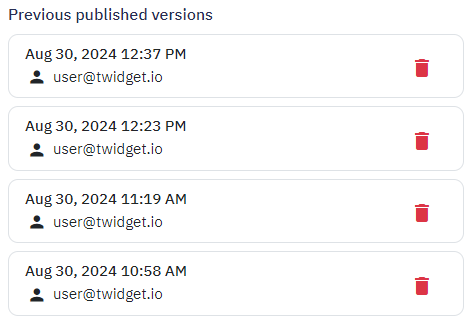With Twidget's publishing feature, you can seamlessly push your changes live, ensuring that your updates take effect on the specified endpoint, function, or event. This feature also allows for version control, enabling you to revert and manage different versions of your changes effectively.
-
In the sidebar, you will have the option to add a message. This message acts as a summary for the changes you are making. It is recommended to add a brief description to keep track of the modifications.

After optionally adding your publish message, click on Publish. Your changes will now go live, and a new published version will be stored in the system.

Twidget stores each published version, allowing you to:
Revert to Previous Versions: You can roll back to any previously published version at any time.
Delete Published Versions: If needed, you can also delete specific published versions, restoring the endpoint, event, or feature to an earlier state.

Publishing Changes:
Click the Publish button to open the publish sidebar.
Optionally, add a summary message.
Click Publish to go live with the changes.
Version Control:
Each publish is stored for future reference.
You can revert to or delete any published versions as necessary.
By following these steps, you ensure that your updates are made live efficiently with a robust version control system, allowing you to navigate forwards and backwards in your change history.
Data Types
Twidget supports six main data types to facilitate interactions within the platform. These data types are essential for defining inputs, outputs, and table fields, helping users understand the nature of the data being handled. The available data types in Twidget are as follows: Text. - Description: ...
Variables
Variables are essential building blocks in Twidget that allow you to store and manipulate data dynamically within your no-code applications. They enable you to create flexible and interactive applications by holding values that can be changed and referenced throughout your workflow. Creating Variabl...
Functions
In Twidget, you can build custom reusable functions. These functions can be utilized across various sections including endpoints, events, and other functions. Instead of creating the same commands repeatedly, you can create a function once and reuse it wherever necessary, making your workflow more e...
Changes
In Twidget, every modification you make in our no-code builder is meticulously documented and stored as a change. Whether you are creating an input or editing a command, each action is captured in the platform. Important: Please note changes will not go live until they are published. Viewing Changes...
Command Output
Some commands in Twidget return outputs, which are essential for dynamic and conditional logic within your workflows. These outputs are displayed next to the command and are prefixed with an "as" to indicate the variable name. Using Output Variables. Once a command returns an output, you can use the...